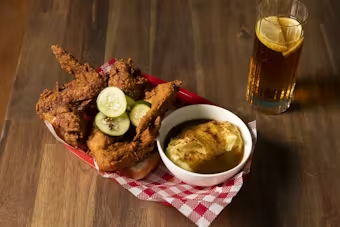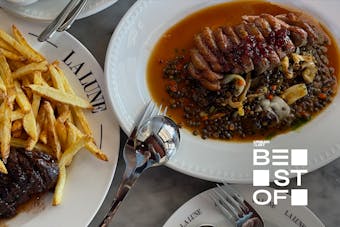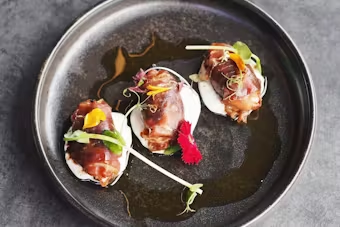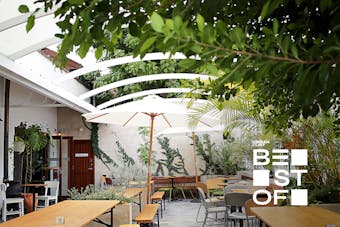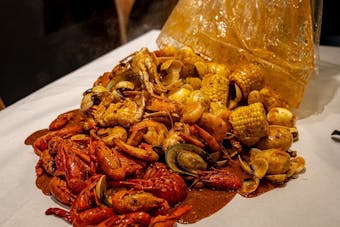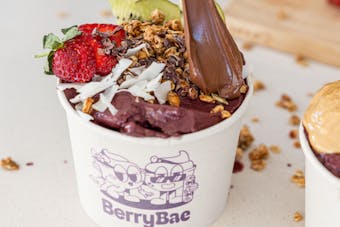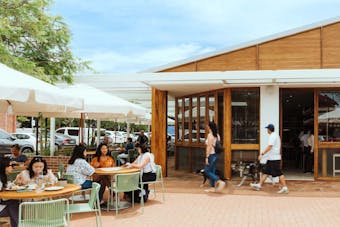Trending
100 Of Australia’s Best Breakfasts, According To Our Editors
From Melbourne’s bustling cafes to Sydney’s vibrant brunch spots, all the way to Brisbane’s innovative morning eats and Perth’s beachside beauties, we’ve curated the ultimate guide to breakfast across Australia.
The Best Perth Restaurants To Tick Off In 2025
Regardless of what you’re in the mood for, one of these places should have you sorted. It’s a tough list to narrow down, but here are the very best restaurants in Perth, in no particular order (because that would just create too many arguments).
21 of Perth’s Best Family Staycays
Need a cheeky little family holiday but want to avoid a major drive or flight? We’ve found some fantastic kid-friendly accommodation options around Perth or within a few hours for you to play and stay with the entire family, without losing a day to travel delays.
The Latest
Your Guide To Stress-Free And Wallet-Friendly Travel In 2025
Through a combination of cost-cutting techniques and selective use of annual leave, you can increase the number of holidays you go on in your lifetime without sending your miscellaneous bills through the roof.
How Roberta Pecoraro Turns Mid-Week Chaos Into Heartfelt Moments On A Plate
We all know the five love languages—but for model and home cook Roberta Pecoraro, there’s one missing: cooking.
Indulge In A Staycay Where Self-Care Looks Like Pink High Tea And Cocktails
A city staycation with good food, cocktails and a day spa? Sounds like self-care to us.
Bang On Brows
Bang On Brows has you covered when it comes to flawless arches, shaping, tinting, laminating and cosmetic tattooing. With plenty of other locations around Perth and a strong rep for natural results and skilled brow artists, you’ll leave feeling fresh and polished. They offer lash lifts, waxing and other facial treatments if you want to level up your glow while you’re there.
The Heritage Wine Store & Bottle Shop
If you find yourself by The Heritage, swing next door to uncover this premium wine store and bottle shop, a must-visit for vino lovers. You’ll find a curated selection of Aussie wines alongside iconic European producers who inspire them, and a top-notch lineup of spirits, beers, bottled cocktails, non-alc drops and fine wine accessories.
Pink Taquito
Pink Taquito is the latest chapter of the Stories precinct, and the pretty-in-pink partner venue to the upstairs Ugly Baby. Bringing a fiery new take on modern Mexican, it is an electric space where tequila-based cocktails and ‘grammable moments are front and centre.
Light Years
Already loved in Byron Bay, Noosa, Newcastle, Gold Coast and Burleigh Heads, Light Years has opened its doors here in Perth. The upbeat Asian diner promises punchy plates and a curated wine list featuring plenty of local vino.
Where To Go Ice Skating In Perth
Perth isn't a place that many would associate with ice skating—us Perthlings don't bat an eyelash at 40 degree days and complain when the temps hit lows of 18—but it turns out ice skating in Perth is very possible and it's all sorts of fun.
All The Best Things To Do, Eat And See In Esperance
If you’re dreaming of a winter escape that trades skyscrapers for salt spray, crackling fires, and coastal hikes with zero crowds — Esperance is calling.
The Feed | All The Perth Food News You Need To Know
With so much Perth food news going down it's easy to miss a thing or two, but luckily we've got you covered. Here's all the Perth food news you missed this week.
DEADBEAT
It's the counter-culture can and cocktail bar meets metal speakeasy that's just landed in Perth (with a mighty burnout baptism to welcome it to the neighbourhood). DEADBEAT is a callback to the subcultures of the 80s and 90s, bringing metal mayhem to the CBD.
Holly Garvey
A new address, but the same incredible lavish services and bespoke interiors, Holly Garvey remains one of Perth’s most coveted beauty destinations. From professional brow and lash makeovers to flawless makeup application by industry experts, this studio is the ultimate go-to.
The Standard
We haven’t yet found a box that The Standard in Northbridge doesn’t tick. It’s a bar, with a rooftop and an incredible food and drink offering running the gauntlet from bar snacks to more substantial fare. There’s a gorgeous wine garden out the back and it’s the perfect venue for everything from casual Wednesday night drinks or a quiet dinner date, to a full-blown affair with all of your pals.
Lot One
If breakfast is your favourite meal of the day – then Lot One is perfect for you. Open every day of the week from early morning to mid-afternoon, Lot One offers an extensive brunch and beverage menu, with plenty of options for the little ones too. Think unique cocktails and a vast food menu ranging from buttermilk pancakes to poke bowls.
19 Best Beach Houses Near Brisbane For Your 2025 Coastal Vacay
Book yourself the ultimate trip with a little help from these ultra-luxe Airbnb beach houses near Brisbane, and don’t forget to pack the snacks (or the sunblock).
From Classiccore To The New Business Casual: Suss Our Crew’s Trending Op Shop Finds
Meet classiccore—the lover of all things crisp collars and sensible loafers, and the rise of new business casual—less blazer, more personality.
Minimalist Matrix Is Trending: Here’s How We Thrifted The Look
Whether it’s Hailey, Kendall, Bella—or the mysterious man serving straight looks outside your local—the minimalist matrix aesthetic is having a moment.
Gage Roads
Fremantle's home for great brews and harbour views, Gage Roads is the type of venue that makes everyone feel welcome. Bringing their quality beers to a brand new brewpub, the outpost sits pretty on the edge of the Fremantle Harbour in the iconic Fremantle A Shed, offering incredible harbourside views.
Vin Populi
Looking for incredible Italian and a stunner of a wine menu south of Perth? Look no further than Vin Populi, a wine bar offering a thoughtful menu of specialty Italian dishes.
Heyscape Denmark
Heyscape is proving once and for all that size doesn’t matter. WA’s very own tiny-cabins crew have just added even more off-grid accommodation to their cabin famiglia, launching a trio of cabins in idyllic Denmark.
Magic Apple Wholefoods
The wait is over—Magic Apple Wholefoods has officially opened on Cottesloe Beach, boasting an unparalleled destination for wellness-focused dining after a stunning $2 million reno.
Everywhere To Eat, Drink And Play At The City2Surf 2025
Once you’ve crossed the finish line, cool down, kick-on and soak up the scenery at Sydney’s best bars, restaurants and hotels.
Best Shows And Movies On Disney Plus Australia (July 2025 Edition)
Kick back and dive into the best Disney+ has to offer in Australia and New Zealand for 2025.
46 Of The Best Movies On Netflix Australia To Stream Tonight (July 2025)
Stay updated with the best movies and documentaries on Netflix Australia this summer. Your ultimate streaming guide is here.
Miss Chow’s Margaret River
One of Perth’s fave Asian fusion dining hotspots is headed down south. Miss Chow’s is setting up shop at the beautiful Edwards Estate in late November.
Short Order Burger Co, Baldivis
With open arms, we welcome Short Order Burger Co's third restaurant—bringing their trademark beef and chicken burgs, FNZ Nashville hot chicken sandwiches, Gelato Bam Bam goods and more to a fresh new space in Baldivis
Shiish Kebab
Ever tried a Berliner kebab? If not, you’ve been seriously missing out. Don’t fret though—now you can get your hands on them right here in P-town. From the brains behind Fremantle’s Belle K Cronut Bar, Shiish Kebab has opened its doors as the first place in Perth to serve up these indulgent foodie delights
Welcome To Truffle Season: Here’s Where To Celebrate The Fancy Fungi In Perth
Whether you're a seasoned truffle tragic or new to the elusive (and expensive) ingredient, now is the time to loosen the belt buckle and indulge. From luxurious one-off long-table dinners to multi-course menus with truffle-dusted desserts, here’s where to get your fix of WA’s most prized seasonal ingredient this year.
The Best Things To Do In Perth This Weekend
It’s another bustling weekend around town so get excited and take advantage of the fabulous events happening all over Perth.
The Dreamiest Perth Facials To Indulge In Right Now
With salons and spas aplenty, where does one go to pamper their precious skin in Perth? Who offers the crème de la crème of facial treatments?
The Bayswater Hotel
The Baysie is back! After a whopping $7m renovation and a twelve month hiatus, beloved boozer the Bayswater Hotel will re-open its doors from 4 October, more than 150 years since it poured its first pint.
Lush Skin and Body
Lush is a five star haven you will never want to leave. Escape real life for an hour or two and pop into this stunning spa for a treatment that will have you feeling like royalty. The Hollywood Facial combines an enzyme peel, LED light therapy, Gua Sha facial massage and an indulgent scalp and hand massage. You’ll float out the door with dewy skin for days.
Element Health And Wellness Centre
From the explosion of run clubs, saunas and ice baths around town, there's no escaping that Perth is in its wellness era right now. The latest (and most advanced) wellness offering to hit Perth, though, is here at Element Health And Wellness Centre.
Fallow Liquor and Eatery
Fire-kissed cuisine is what it's all about at Fallow Liquor and Eatery, Northbridge's new multi-level tavern brought to us by some of Perth's most leading restaurateurs.
Squid Game’s Back For A Final Season: Here’s What You Need To Know
The global phenomenon that broke Netflix records, sparked countless Halloween costumes and gave an all-new meaning to ‘red light, green light’, is gearing up for one final twisted, terrifying round.
20 Mount Lawley Restaurants And Bars To Tick Off Your List
From refined casual dining spots that face the colourful street to the cheap and cheerful eateries that fill the area’s various lanes and arcades, the top-notch eats are plentiful in this neck of the woods
Rain, Hail or Toddler Tantrum, These Perth Indoor Pools Are A Wet Weather Lifesaver
We know how much kids love swimming and playing in the pool during the summer, so the winter school holidays can feel a little lacklustre in comparison. But don't worry, Perth’s best indoor swimming pools are here to save the day (and your sanity). Whether you’re escaping the rain or just chasing a fun-filled family day out, these indoor aquatic centres are packed with kid-friendly features to keep everyone entertained.
The Lunch Shack
We’re officially calling it—this new retro-inspired lunch bar in Margaret River is flipping some of the best breakfast burgers in the South West. And with a motto of “Flipping Good Food,” it’s easy to see why locals are already flocking to this spot, led by the friendly trio Liz, Miki and Arlo.
Jollie Macarons
When a former industrial chemist decides to apply their lab-like precision and natural curiosity to macaron baking it should come as no surprise that the outcome is nothing short of perfection.
Gibney
White tablecloths, marble, jacketed wait staff and caviar bumps—Gibney is hands down the fanciest of all the venues under George Kailis' name. And honestly, it might just take the cake for 'most opulent dining destination' in all of Perth.
South Bird
Start locking in your chicken shop dates, 'cause the crew behind Northbridge icons The Bird and Ezra Pound have just unveiled their new direction for the former North Bird space on William St—a dedicated Nashville hot chicken joint called South Bird.
These Are The Sights, Scents And Flavours That Define A Trip To Brisbane
Next-gen artists lighting up the city, tropical islands, ancient rainforests and sun-soaked afternoons await.
Buckle Up And Plan Your Next Trip With This New Pooch-Friendly Travel Platform
Sure, vacays are great—but let's be real, they’re SO much better with our four-legged friends in tow.
Albany’s Best Things To Do, Eat And See
Down in WA’s Great Southern, Albany serves up moody natural landscapes, seriously good food, and just the right amount of small-town charm. It’s the kind of place where you can start your day with ocean views, spend the afternoon exploring windswept beaches or epic hiking trails, and wind down with a cracking local wine and some top-notch bites.
Coffee Heads
Big call, but the roast chicken roll at Coffee Heads might just be our favourite thing to come out of 2023. The warm, succulent roast chicken, the herby remoulade, the slightly toasted potato bun—it's giving rooster roll nostalgia in the very best way and is the one thing we'll always make time for on a road trip down south.
Will St
One of the few silver linings to come out of COVID was when Will Meyrick—the chef-owner behind super popular Balinese establishments Sarong and Mama San (to name a couple)—decided to move his family here while Bali was in shutdown mode and open up his own Perth venue, Will St.
Garum
Guy Grossi's gift to Perth, Garum, is the large-scale Roman restaurant attached to the beautiful Westin Perth hotel on Hibernian Place.
The Corner Dairy
Nestled on the corner of Woodside Street and Scarborough Beach Road, The Corner Dairy has nailed the casual coastal vibe with a standup selection of craft brews and wines, paired with local produce-driven plates courtesy of Chef James Cole Bowen (ex-Le Rebelle).
The Best Perth Restaurants To Tick Off In 2025
Regardless of what you’re in the mood for, one of these places should have you sorted. It’s a tough list to narrow down, but here are the very best restaurants in Perth, in no particular order (because that would just create too many arguments).
The Best Perth Degustations And Fine Dining Restaurants
Degustation dining is the absolute peak of eating out. Nothing conjures the same luxurious, almost Roman opulence like a meal that comes in seven stages.
The Best Fremantle Restaurants To Dine At Right Now
With beautiful old buildings, bucket loads of charm, a reputation for quality produce and some seriously chilled vibes, it's little wonder Fremantle is a Perth foodie mecca. From the new kids on the block to the ones that hold a special place in our heart, we’ve rounded up the best Fremantle restaurants you need to visit next time you're in the Port City.
Mandoon Estate
Just 25 minutes from Perth, Mandoon Estate has established itself as a must-visit Swan Valley destination for wining and dining.
Romulus
The charming Sayers cafe site in Leederville has gone through quite the transformation since Mirko Silvestri—the same Roman-born legend behind beloved Mount Hawthorn Italian joint, LupoLab—scooped up the spot last year.
Il Falco
There are plenty of awesome pizza restaurants in Perth, but this newbie from the same team who brought us Jetty Bar, Subi Continental, Ruin Bar and Pretty Good Pizza has quickly become our new fave.
The Best Leederville Restaurants And Bars To Pop On Your List
Home to some of Perth’s coolest cafes, restaurants, bars and shops, Leedy may be small but she’s really carved a space in our hearts over the years. The Leederville strip is brimming with everything from bite-size tapas and Asian eats to iconic pub meals and contemporary share plates.
From Mozzarella Workshops To Truffle Feasts, Nom Nom Returns To Spice Up Your Winter
Leederville’s beloved winter festival Nom Nom is back for its third delicious year, dishing up six weeks of food, wine and music from Monday 7 July to Sunday 17 August 2025.
The Best Bars In Perth To Sip At Right Now
There have been very few things as difficult as narrowing down a list of the best bars in Perth, but we’re giving it a go. We’ve spent many a night trailing around our city, sampling one too many drinks and bar hopping around all in the name of narrowing down this list.
Kickin Inn Perth
Hailing from the east coast, the new Kickin Inn Perth restaurant offers up a southern style seafood boil dining experience with no cutlery or plates.
Busselton Pavilion
It’s time to line up a road trip, as the south west’s long-awaited Busselton Pavilion has just thrown open its doors. The brand, spanking new multi-use venue comes from hospo powerhouse, John Parker (The Royal Hotel, Fleur, Willi’s Wine Bar, The Standard and Dandelion) and includes a restaurant, pub, private dining rooms, wine shop and in-house distillery, with enough space for 500 guests inside the breezy heritage-style stunner.
Berry Bae
Perth just scored a stunning self-serve acai bar to help you through the summer. Much like the wildly popular frozen yoghurt bar experience at Yo-Chi, Berry Bae will let you completely customise everything. Choose how much acai you want then go to town on the toppings, with everything from fresh fruit and granolas (including gluten-free options) to secret sauces, Nutella and next-level sweet treats. Once you’re done, simply weigh, pay and go. Berry Bae is open in Leederville now.
Mortadeli
You'd think this Nedlands gem had been here for decades given how chummy customers are with the man behind the counter.
Adore Beauty’s First IRL Perth Store Has Landed, Tim Tams In Tow
Skincare lovers are in for a treat, Adore Beauty's very first brick and mortar Perth store is ready to open its doors, and the early skincare bird is truly set to get the proverbial worm as the first 300 customers through the doors will be gifted a free goodie bag packed with 15 deluxe samples, so if you see me in line tomorrow during office hours, no you didn't.
Virgin Australia Has Just Launched A Massive 4-Day Flight Sale To Fiji, Bali And New Zealand
Flights from $49 one way sound tempting? Here’s all the intel you need about the Virgin Australia sale.
The Best Cafes In Leederville Right Now
Leederville has always batted above average on the cafe front and in 2025, it’s clear the suburb is still swinging hard. Whether you’re craving a seriously good brew, lazy brunch with mates, or a sunny solo perch for people-watching, Leedy’s buzzing cafe scene continues to deliver. From old favourites still packing out tables to shiny new arrivals bringing fresh flair, there’s no shortage of delicious stops lining Oxford Street and beyond.
The Station
After two successful heritage transformations, Nokturnl—the hospo crew behind popular multi-venue precincts The Old Synagogue (Fremantle) and The Beaufort (Mount Lawley)—are set to do it all again; this time with a 1908 federation style Police Station on the corner of Labouchere Road and Mends Street in South Perth.
Canteen Pizza Applecross
When Cottesloe fave, Canteen Pizza, closed up in March, we shed more than a few tears. Originally launched as a pop-up in 2017, the seaside pizzeria quickly became a staple thanks to its practically perfect woodfired pizzas, great drinks and cruisy atmosphere. Well, now, Canteen Pizza is finally back.
6Head Perth
One of Sydney's most iconic steakhouses, 6HEAD, has finally made its way out west, with a super slick new restaurant now open at the base of the new Chevron Tower at One The Esplanade in Elizabeth Quay.
Ode To Sirens
Looks like Northbridge isn’t the only one sporting a cool listening bar these days, thanks to the opening of Ode To Sirens—a new 70s-infused vinyl bar located in the front bar of the old P&H Hotel in the heart of Freo.









.png?auto=format,compress&w=340&fit=crop&ar=3:2)






































